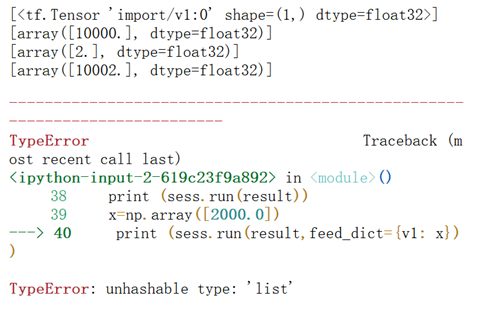学习过程是Tensorflow 实战google深度学习框架一书的第六章的迁移学习环节。
具体见我提出的问题:https://www.tensorflowers.cn/t/5314
参考https://blog.csdn.net/zhuiqiuk/article/details/53376283后,对代码进行了修改。
问题的跟踪情况记录:
1 首先是保存模型:
import tensorflow as tf from tensorflow.python.framework import graph_util v1=tf.constant([10000.0],name='v1') #v1 = tf.placeholder(tf.float32,shape=[1],name='v1') v2 = tf.Variable(tf.constant(2.0, shape=[1]), name = "v2") result = v1 + v2 init_op = tf.global_variables_initializer() with tf.Session() as sess: sess.run(init_op,{v1:[100]}) print (sess.run(result,{v1:[1000]})) writer = tf.summary.FileWriter('./graphs/model_graph', sess.graph) writer.close() graph_def = tf.get_default_graph().as_graph_def() output_graph_def = graph_util.convert_variables_to_constants(sess, graph_def,['add']) with tf.gfile.GFile("Saved_model/combined_model.pb", "wb") as f: f.write(output_graph_def.SerializeToString())
因为inception v3接受输入的tensor是Decode/Content:0,是一个const类型,就是tf.constant类型,而一开始,我并不明白问题的所在,就将tf.placeholder改为了tf.constant,而实际上,两个都可以。问题的本身不是出在这里,而是对书本有错误的理解。
书上因为获取的是两个return elements,会自动从列表中取出元素。
而我获得的是一个retrun elelment,则只能返回一个列表。
2 使用并加载持久化模型,直接调用模型的训练参数进行计算。
#这是我以前写的程序,是错误的 """ 因为我以前写的只是获取一个值。 而现在修正的v1则是一个tensor。我们可以修正tensor的值。 所以,tensorflow 实战google深度学习框架中有重大bug。 不懂的联系我手机 18627711314 杰 """ import tensorflow as tf import numpy as np from numpy.random import RandomState from tensorflow.python.platform import gfile with tf.Session() as sess: model_filename = "Saved_model/combined_model.pb" #model_filename = "inception_dec_2015/tensorflow_inception_graph.pb" with gfile.FastGFile(model_filename, 'rb') as f: graph_def = tf.GraphDef() graph_def.ParseFromString(f.read()) """将模型的相关信息写入文件,和利用tensorboard进行可视化 f = open("xiaojie2.txt", "w") print ("xiaojie2 ",file = f) print (graph_def,file=f) f.close() writer = tf.summary.FileWriter('./graphs/model_graph2', graph_def) writer.close() """ """④输出所有可训练的变量名称,也就是神经网络的参数""" trainable_variables=tf.trainable_variables() variable_list_name = [c.name for c in tf.trainable_variables()] variable_list = sess.run(variable_list_name) for k,v in zip(variable_list_name,variable_list): print("variable name:",k) print("shape:",v.shape) #print(v) """④输出所有可训练的变量名称,也就是神经网络的参数"""
v1= tf.import_graph_def(graph_def, return_elements=["v1:0"]) print (v1) print (sess.run(v1)) v2= tf.import_graph_def(graph_def, return_elements=["v2:0"]) print (sess.run(v2)) result = tf.import_graph_def(graph_def, return_elements=["add:0"]) print (sess.run(result)) x=np.array([2000.0]) print (sess.run(result,feed_dict={v1: x}))
这些都是参照书上使用inception模型时的做法,我参照着自己写了一个模型,但是有重大bug
运行结果总是提示:

因为总是无法用feed_dict传入我想计算的输入。我一开始因为是tf.placeholder的原因,就参照inception的改为tf.constant。但是还是不行。后来在网上看到别人加载pb文件的一段代码https://blog.csdn.net/zhuiqiuk/article/details/53376283,重新对代码进行了修正。如下:
import tensorflow as tf import numpy as np from numpy.random import RandomState from tensorflow.python.platform import gfile with tf.Graph().as_default(): output_graph_def = tf.GraphDef() output_graph_path='Saved_model/combined_model.pb' with open(output_graph_path, "rb") as f: output_graph_def.ParseFromString(f.read()) _ = tf.import_graph_def(output_graph_def, name="") with tf.Session() as sess: """④输出所有可训练的变量名称,也就是神经网络的参数""" trainable_variables=tf.trainable_variables() variable_list_name = [c.name for c in tf.trainable_variables()] variable_list = sess.run(variable_list_name) for k,v in zip(variable_list_name,variable_list): print("variable name:",k) print("shape:",v.shape) #print(v) """④输出所有可训练的变量名称,也就是神经网络的参数""" input_x = sess.graph.get_tensor_by_name("v1:0") result = tf.import_graph_def(graph_def, return_elements=["add:0"]) print (input_x) x=np.array([2000.0]) print (sess.run(result,feed_dict={input_x: x}))

问题的根本在于:
V1= tf.import_graph_def(graph_def, return_elements=["v1:0"])获取的是
[<tf.Tensor 'import/v1:0' shape=(1,) dtype=float32>],是一个列表
而:input_x = sess.graph.get_tensor_by_name("v1:0")
获取的是一个Tensor,即Tensor("v1:0", shape=(1,), dtype=float32)。
使用sess.run的时候,feed_dict要修正的是tensor,而不是一个list。因此,总会提出unhashable type:listd的报错。
3 将原始错误程序的代码改为:
v1= tf.import_graph_def(graph_def, return_elements=["v1:0"]) print (v1) print (sess.run(v1)) v2= tf.import_graph_def(graph_def, return_elements=["v2:0"]) print (sess.run(v2)) result = tf.import_graph_def(graph_def, return_elements=["add:0"]) print (sess.run(result)) x=np.array([2000.0])
#print (sess.run(result,feed_dict={v1: x}))
print (sess.run(result,feed_dict={v1[0]: x}))
也可以正确运行
4 后来正确的程序还可以改为:
import tensorflow as tf import numpy as np from numpy.random import RandomState from tensorflow.python.platform import gfile output_graph_def = tf.GraphDef() output_graph_path='Saved_model/combined_model.pb' with open(output_graph_path, "rb") as f: output_graph_def.ParseFromString(f.read()) _ = tf.import_graph_def(output_graph_def, name="") with tf.Session() as sess: """④输出所有可训练的变量名称,也就是神经网络的参数""" trainable_variables=tf.trainable_variables() variable_list_name = [c.name for c in tf.trainable_variables()] variable_list = sess.run(variable_list_name) for k,v in zip(variable_list_name,variable_list): print("variable name:",k) print("shape:",v.shape) #print(v) """④输出所有可训练的变量名称,也就是神经网络的参数""" input_x = sess.graph.get_tensor_by_name("v1:0") result = tf.import_graph_def(graph_def, return_elements=["add:0"]) print (input_x) x=np.array([2000.0]) print (sess.run(result,feed_dict={input_x: x}))
需要注意的是:
首先,无论如何,加载pb以后,输出所有可训练的变量,都不可能输出持久化模型中的变量。这一点以前就说过。以前说过,只能使用train.saver的方式。
其次,如果使用后一种方式,即sess.graph.get_tensor_by_name,则必须要有红黄标注的那一幕。即:_ = tf.import_graph_def(output_graph_def, name="")
程序附件
链接:https://pan.baidu.com/s/11YtyDEyV84jONPi9tO2TCw 密码:8mfj